This website uses cookies
We use cookies to personalise content and ads, to provide social media features and to analyse our traffic. We also share information about your use of our site with our social media, advertising and analytics partners who may combine it with other information that you’ve provided to them or that they’ve collected from your use of their services.
Cookie Policy
What are cookies?
A cookie is a small text file that a website stores on your computer or mobile device when you visit the site.
- First party cookies are cookies set by the website you're visiting. Only that website can read them. In addition, a website might potentially use external services, which also set their own cookies, known as third-party cookies.
- Persistent cookies are cookies saved on your computer and that are not deleted automatically when you quit your browser, unlike a session cookie, which is deleted when you quit your browser.
Every time you visit our websites, you will be prompted to accept or refuse cookies. The purpose is to enable the site to remember your preferences (such as user name, language, etc.) for a certain period of time. That way, you don't have to re-enter them when browsing around the site during the same visit.
Cookies can also be used to establish anonymised statistics about the browsing experience on our sites.
How do we use cookies?
Currently, there are four types of cookies that may be generated as you browse our site: Strictly Necessary, Statistics, Preference and Marketing cookies.
1. Strictly Necessary Cookies
These cookies are essential for you to browse the website and use its features, such as accessing secure areas of the site. Cookies that allow web shops to hold your items in your cart while you are shopping online are an example of strictly necessary cookies. These cookies will generally be first-party session cookies. While it is not required to obtain consent for these cookies, what they do and why they are necessary are explained in the table below.
How do I control Strictly Necessary Cookies?
You can use your browser settings to control whether or not we set session cookies. More information on your browser settings is provided at the bottom of this page.
Please be aware that these cookies are critical to the efficient working of the site. If you choose to disable these cookies from this site, the functionality of the site may be greatly reduced.
2. Statistics Cookies
Also known as "performance cookies," these cookies collect information about how you use a website, like which pages you visited and which links you clicked on. None of this information can be used to identify you. It is all aggregated and, therefore, anonymized. Their sole purpose is to improve website functions. This includes cookies from third-party analytics services as long as the cookies are for the exclusive use of the owner of the website visited.
Statistical information is used in reports and to improve our site. For example, we have used analytics data to add, remove or change features of the site based on how popular they are with users.
We track, for example:
- the numbers of visitors to individual pages;
- when pages were visited;
- how long users stayed on the page;
- the IP address of the user of the website;
- the page they came from;
- technical data about the device being used to browse the site (such as browser and operating system version, and display size) — we use this data to ensure that the technology our site uses is appropriate for the majority of our users, and how best to display the site for users who have less capable browsers.
More information about Statistics cookies
We use cookies from different partners including Google to provide our analytics data. You can read more about how Google Analytics treats your data on their web site. You can also read Google's full privacy policy.
How do I control Statistics cookies?
Google provides a tool to opt-out of Google Analytics. This is available for all modern browsers in the form of a browser plugin. Additionally, you can control how cookies are set using your browser settings.
3. Preference cookies
Also known as "functionality cookies," these cookies allow a website to remember choices you have made in the past, like what language you prefer, whether you have accepted our cookie policy, what region you would like weather reports for, or what your user name and password are so you can automatically log in.
4. Marketing cookies
The advertisements you see displayed on this, and other, sites are generated by third parties. These services may use their own anonymous cookies to track how many times a particular ad has been displayed to you and may track your visits to other sites where their ads are displayed. Please note that advertisers can only track visits to sites which display their ads or other content. This tracking is anonymous, meaning that they do not identify who is viewing which ads.
Tracking in this manner allows advertisers to show you ads that are more likely to be interesting to you, and also limit the number of times you see the same ad across a wide number of sites. As an example of how advertisers operate, if you recently researched holidays, adverts for holiday operators may subsequently appear on our sites.
We do not have access to, or control over, these third party cookies; nor can we view the data held by these advertisers. Online advertisers provide ways for you to opt-out of your browsing being tracked. More information about the advertisers we use, and how to opt-out, is provided below.
Youtube
We display clips from Youtube related to our purchase opportunities. You can view Youtubes's privacy policy on their website. This page also allows you to control what cookies YouTube saves on your computer.
We work with Google to optimise how Google ads are displayed. You can discover how Google protects your privacy relating to ads at its privacy policy.
Cookie Table of our cookies
Cookies you may see used on konvi.app
| Cookie name | Default expiration time | Purpose | Description |
|---|---|---|---|
| _fbp | 3 months | Marketing cookies | Facebook: to store and track visits across websites. |
| _ga | 2 years | Statistics cookies | Google Analytics: to store and count pageviews. |
| _gat_UA-* | 1 minute | Statistics cookies | Google Analytics: functional |
| _gid | 1 day | Statistics cookies | Google Analytics: to store and count pageviews. |
| _iub_cs-* | 1 year | Preferences cookies | iubenda: to store cookie consent preferences. |
| euconsent-v2 | 1 year | Preferences cookies | To store cookie consent preferences. |
| referrerReferralId | 1 browser session | Strictly necessary cookies | Track user referrals |
| t_gid | 1 year | Marketing cookies | Taboola: assigns a unique User ID that allows Taboola to recommend specific advertisements and content to this user |
| APISID | 2 years | Marketing cookies | Youtube: Google Ads Optimization |
| HSID | 2 years | Marketing cookies | Youtube: to provide fraud prevention |
| LOGIN_INFO | 2 years | Marketing cookies | Youtube: to store and track visits across websites. |
| PREF | 2 years | Marketing cookies | Youtube: to store and track visits across websites. |
| SAPISID | 2 years | Marketing cookies | Youtube: Google Ads Optimization |
| SID | 2 years | Marketing cookies | Youtube: to provide ad delivery or retargeting, provide fraud prevention. |
| SIDCC | 1 year | Marketing cookies | Youtube: to provide ad delivery or retargeting, provide fraud prevention. |
| SSID | 2 years | Marketing cookies | Youtube: to provide ad delivery or retargeting, provide fraud prevention. |
| VISITOR_INFO1_LIVE | 1 year | Strictly necessary cookies | Youtube: to provide bandwidth estimations. |
| YSC | 1 browser session | Marketing cookies | Youtube: to store a unique user ID. |
| __Secure-1PAPISID | 2 years | Marketing cookies | Youtube: Google Ads Optimization |
| __Secure-1PSID | 2 years | Marketing cookies | Youtube: to provide ad delivery or retargeting, provide fraud prevention. |
| __Secure-3PAPISID | 2 years | Marketing cookies | Youtube: Google Ads Optimization |
| __Secure-3PSID | 2 years | Marketing cookies | Youtube: to provide ad delivery or retargeting, provide fraud prevention. |
| __Secure-3PSIDCC | 1 year | Marketing cookies | Youtube: to provide ad delivery or retargeting, provide fraud prevention. |
| IDE | 1.5 years | Marketing cookies | doubleclick: serving targeted advertisements that are relevant to the user across the web. |
| RUL | 1 year | Marketing cookies | doubleclick: serving targeted advertisements that are relevant to the user across the web. |
| variant | 1 browser session | Strictly necessary cookies | For providing targeted content to users |
| cookie_consent | 1 year | Strictly necessary cookies | For persisting cookie consent |
| 1P_JAR | 1 month | Marketing cookies | Google: optimize advertising, to provide ads relevant to users |
| NID | 1 month | Marketing cookies | Google: to provide ad delivery or retargeting, store user preferences |
Removing cookies from your device
You can delete all cookies that are already on your device by clearing the browsing history of your browser. This will remove all cookies from all websites you have visited.
Be aware though that you may also lose some saved information (e.g. saved login details, site preferences).
Managing site-specific cookies
For more detailed control over site-specific cookies, check the privacy and cookie settings in your preferred browser
Blocking cookies
You can set most modern browsers to prevent any cookies being placed on your device, but you may then have to manually adjust some preferences every time you visit a site/page. And some services and functionalities may not work properly at all (e.g. profile logging-in).
Further help
If you still have any concerns relating to our use of cookies, please contact us at support@konvi.app
Comic books have long held a unique place at the intersection of popular culture and visual storytelling. From their roots in early 20th-century pulp publishing to their evolution into billion-pound media franchises, comics have transitioned from light entertainment to revered historical artefacts. Today, select issues are considered blue-chip collectables, fetching millions at auction and gaining recognition as viable alternative investments.
The Golden Age of Comics (1938–1956) marked the rise of archetypal heroes such as Superman and Batman, with publishers like DC Comics laying the foundation for superhero mythology. The Silver Age (1956–1970) ushered in a wave of creative energy, driven largely by Marvel Comics, which introduced more psychologically complex characters including Spider-Man and the X-Men. These eras are now considered the most investable periods in comic history, with high-grade issues consistently appreciating in value.
What drives this market is a potent mix of nostalgia, scarcity, and cultural significance. Many of the highest-value comics feature first appearances, iconic cover art, or key narrative moments that resonate across generations. As these issues become increasingly scarce—particularly in high-grade conditions—their value continues to climb. According to Fortune Business Insights, the global comic book industry reached a market size of $16.83 billion in 2024, fuelled by the growing popularity of collectables and a new generation of retail investors.
This is where platforms such as Konvi play a role. By enabling fractional ownership in high-value collectable assets starting from just €250, Konvi is transforming access to investment-grade comic books. Through partnerships with experts such as Ewbank’s, a leading UK-based auction house specialising in fine art, antiques, and collectables, for authentication, grading, and valuation, Konvi brings historically significant comics to a broader investing audience.
The Rise of the Comic Book Collectable Market
Comic books were once tucked away in shoeboxes or traded between friends. Today, they are viewed as investment assets with serious market potential. This transformation took shape in the 1990s when nostalgia for early superheroes sparked a renewed interest in Golden and Silver Age issues. Auction houses such as Heritage Auctions and ComicConnect began spotlighting rare comics in headline sales, elevating them within the broader collectables market.
One key factor influencing price is grading, typically conducted by companies like CGC (Certified Guaranty Company). Grading establishes the physical condition of a comic on a 10-point scale, and even a small difference can significantly affect value. A CGC 9.6 comic can be worth several times more than a mid-grade copy of the same issue. The process has brought structure and transparency to the market, attracting investors looking for tangible assets backed by history and culture (Source: Heritage Auctions).
By enabling fractional investment in professionally curated comic books—each authenticated, graded, and securely stored—Konvi eliminates many of the traditional barriers faced by retail investors, providing a trusted entry point into this historically exclusive asset class.
10. All-Star Comics #8 (DC, 1942) – $1.62 Million
Grade: CGC 9.4
Sale Year: 2022
Auction House: Heritage Auctions
All-Star Comics #8 marks the first appearance of Wonder Woman, one of the most iconic figures in comic book history and a trailblazer for female superheroes. Created by psychologist William Moulton Marston, Wonder Woman was envisioned as a response to the hypermasculine hero archetype—a blend of justice, compassion, and feminist ideals.
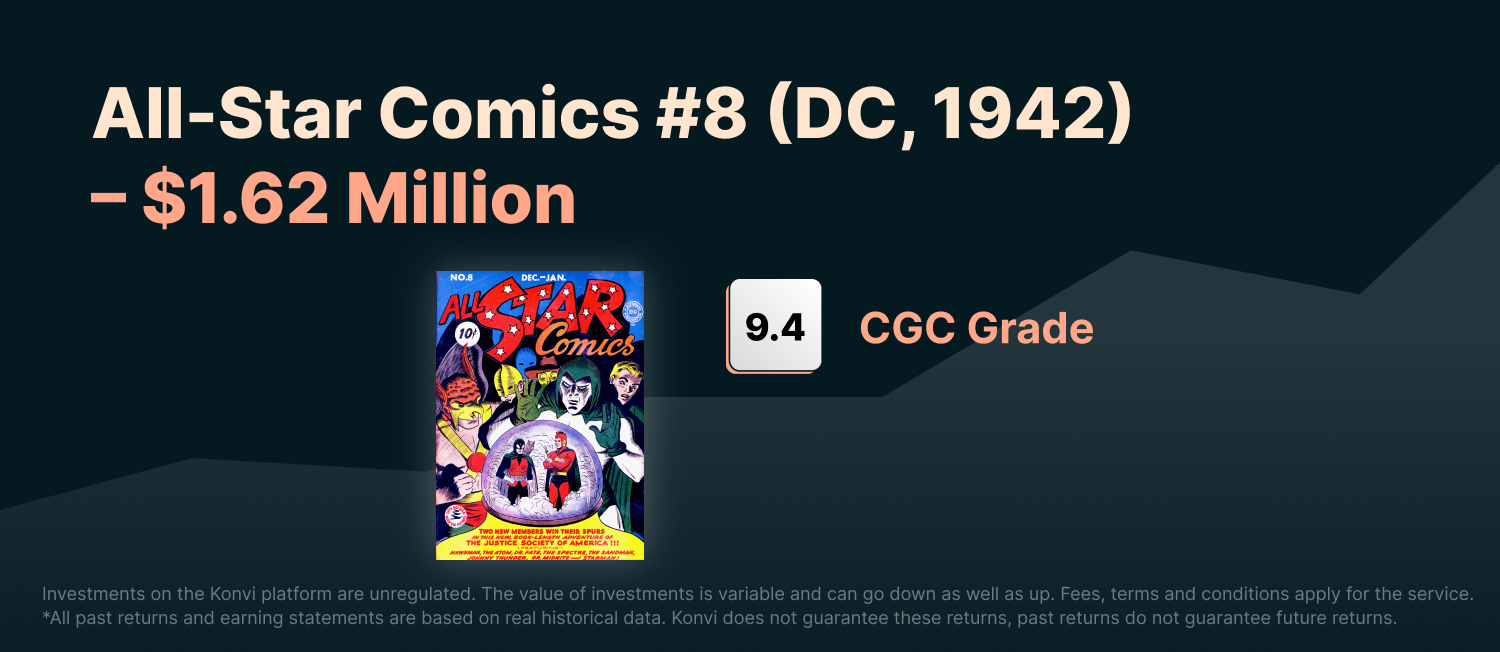
The comic was released during the height of World War II, offering readers a new kind of heroine. What makes this specific copy extraordinary is its CGC 9.4 grade, a near-mint condition previously unseen for this title. With fewer than a handful of high-grade copies in existence, its rarity, combined with the cultural magnitude of Wonder Woman’s debut, makes it one of the most treasured comics ever published.
9. Detective Comics #27 (DC, 1939) – $1.825 Million
Grade: CGC 6.5
Sale Year: 2024
Auction House: ComicConnect
The first appearance of Batman, Detective Comics #27 is widely considered one of the most important comic books ever printed. Created by Bob Kane and Bill Finger, Batman offered a stark contrast to Superman—dark, brooding, and grounded in detective noir rather than superhuman ability.
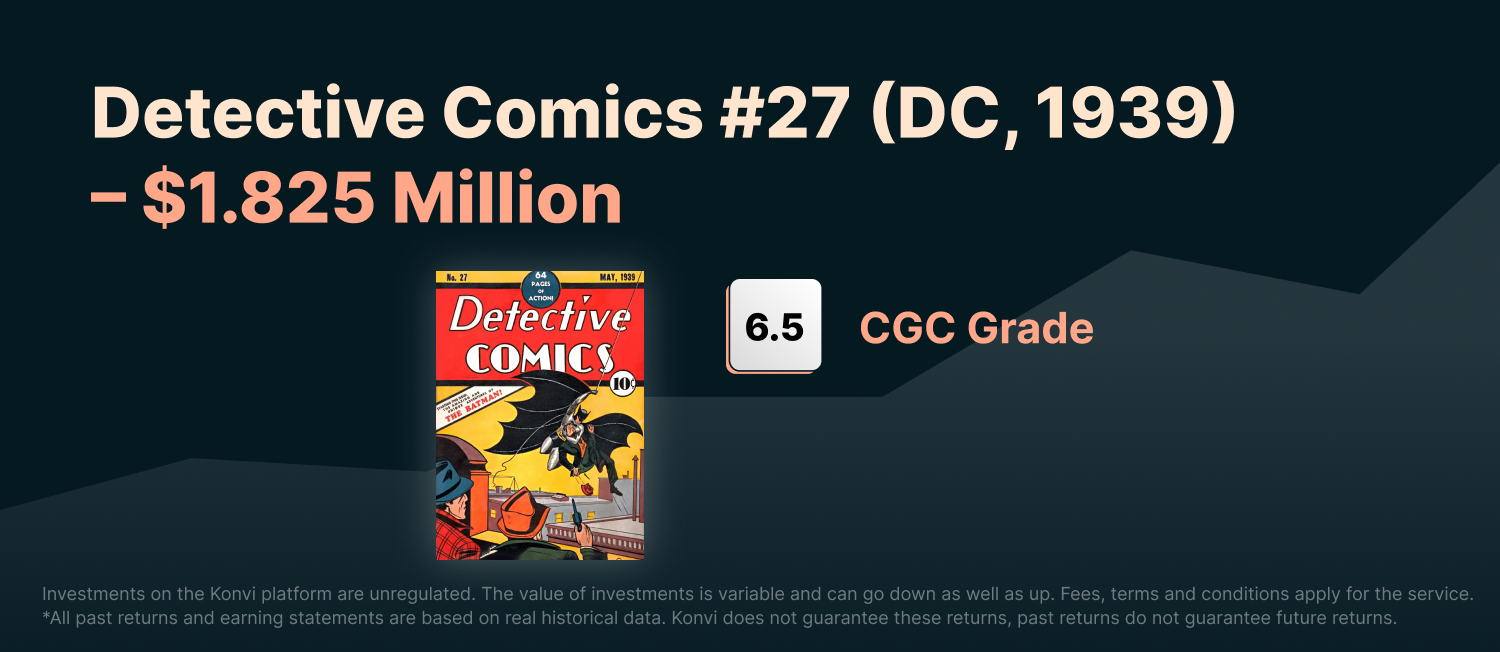
Published in May 1939, this issue introduced Batman, a hero who stood apart from his contemporaries in both tone and philosophy. Unlike Superman’s otherworldly strength or Captain America’s patriotic idealism, Batman was grounded in human limitation—a mortal shaped by personal trauma, operating through intellect, discipline, and moral ambiguity. He didn’t rely on superpowers but instead harnessed fear, detective skills, and physical mastery to combat crime in Gotham’s corrupt underworld. This darker, more psychological approach introduced a noir sensibility to superhero storytelling, redefining what a comic book protagonist could be.
With only 77 copies recorded in the CGC census and even fewer in unrestored, high-grade condition, this issue’s CGC 6.5 rating is exceptional for its era. The lasting demand for early Batman material, combined with the character’s unique place in comic mythology, explains why Detective Comics #27 remains a cornerstone of both cultural and investment value in the comic book market.
8. Tales of Suspense #39 (Marvel, 1963) – $2 Million
Grade: CGC 9.8
Sale Year: 2023
Auction House: ComicLink
Iron Man made his debut in this Cold War-era classic, created by the legendary Stan Lee, Jack Kirby, Larry Lieber, and Don Heck. Tales of Suspense #39 is steeped in political context, with Tony Stark reflecting anxieties about militarisation and technological advancement in the atomic age.
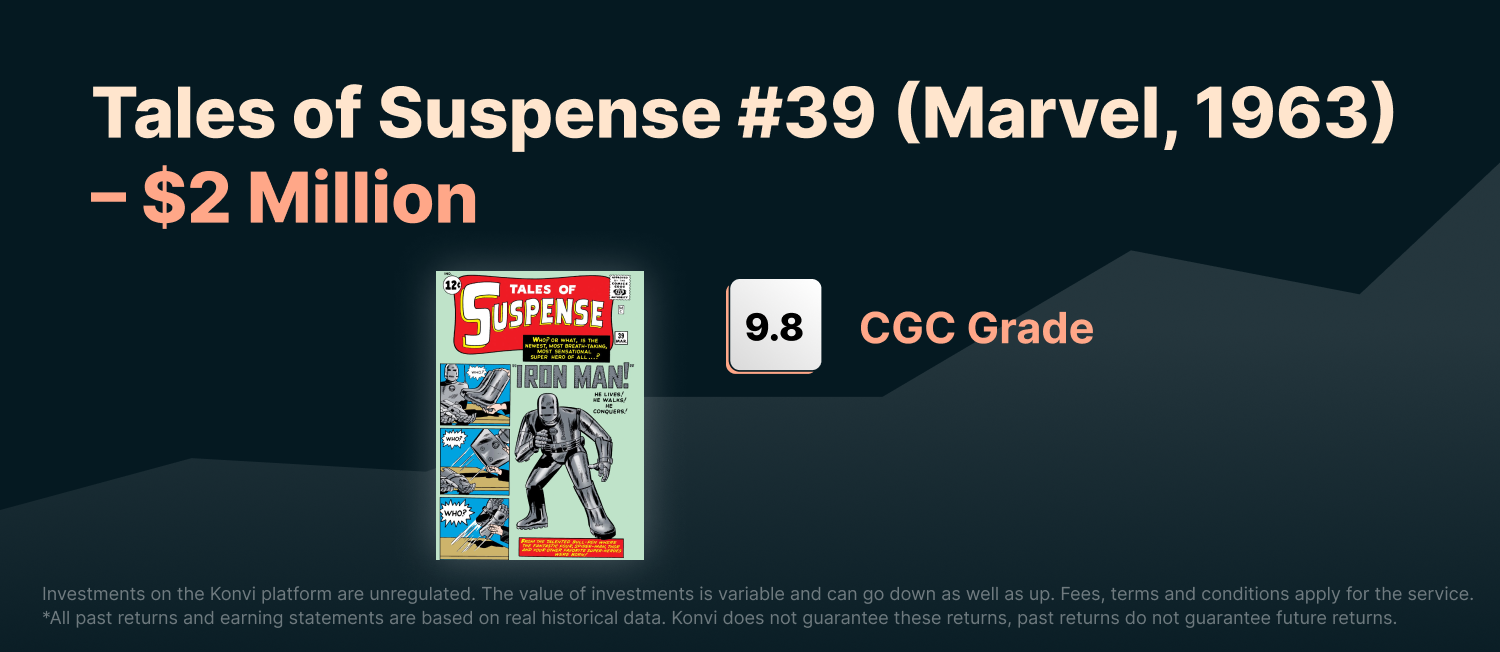
The CGC 9.8 grade is virtually unheard of for comics from the early 1960s. Printed on low-grade newsprint and never intended to be preserved, most surviving copies of Tales of Suspense #39 suffer from colour fading, spine wear, or structural damage. Fewer than a handful have achieved this near-perfect condition, making this particular copy one of the finest-known examples of Iron Man’s debut in existence.
The story itself marked a bold shift in Marvel's approach to heroism. Tony Stark, a weapons manufacturer who suffers a life-threatening injury and re-evaluates his role in global conflict, was a morally complex and deeply human character. His transformation into Iron Man set the stage for a new kind of superhero—flawed, introspective, and shaped by geopolitical realities like the Cold War. That thematic depth, combined with Stan Lee’s signature storytelling and Don Heck’s iconic art, cemented Tales of Suspense #39 as a foundational text in the Marvel Universe.
Iron Man’s resurgence in the 21st century—especially as the linchpin of the Marvel Cinematic Universe—has only intensified interest in his origin issue. The confluence of pristine condition, historical significance, and renewed cultural prominence fully justifies its multi-million-dollar valuation and place among the most sought-after comics in the world.
7. Fantastic Four #1 (Marvel, 1961) – $2.04 Million
Grade: CGC 9.6
Sale Year: 2024
Auction House: Heritage Auctions
This landmark issue is widely credited with launching the Marvel Age of Comics. Created by Stan Lee and Jack Kirby, the Fantastic Four broke from traditional superhero norms—they had no secret identities, argued openly, and navigated personal struggles as a public-facing family. Their relatability introduced a new emotional depth to the genre, redefining comic book storytelling and laying the foundation for the interconnected Marvel Universe that followed.
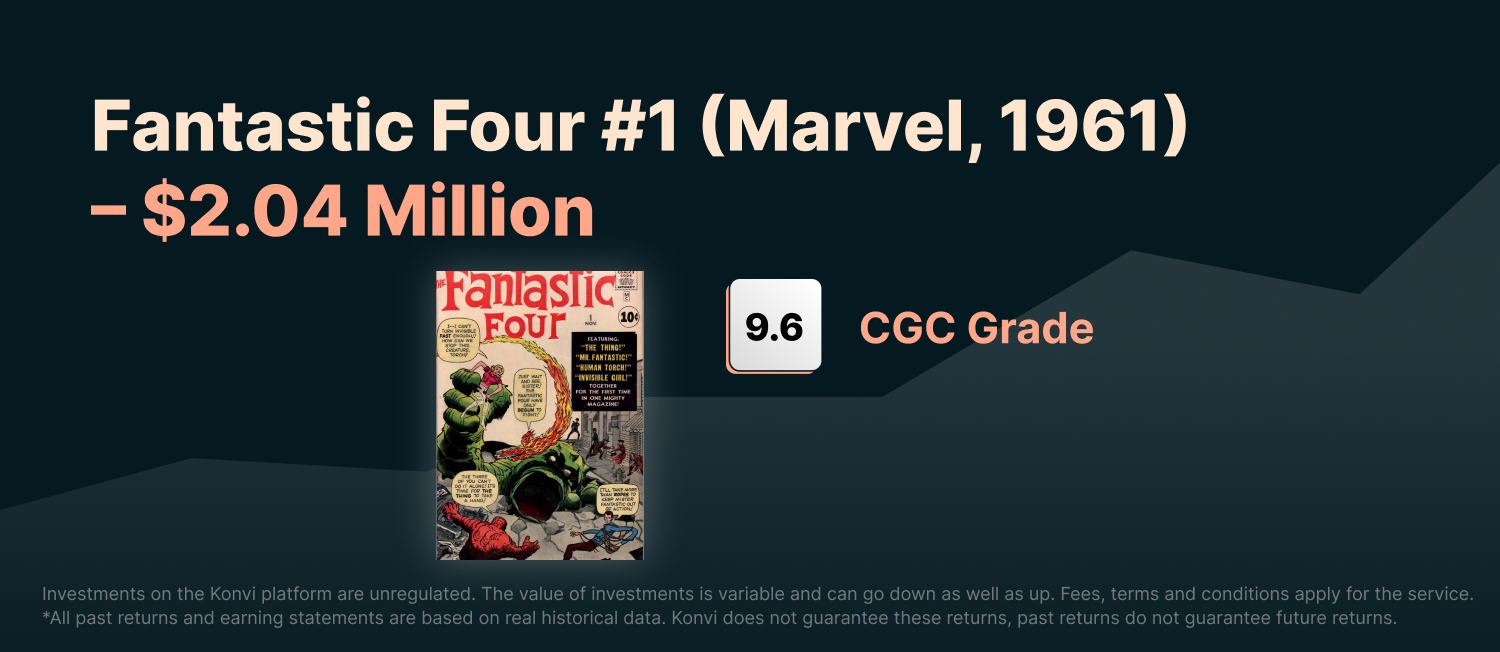
Fantastic Four #1 introduced not just the titular team but an entire ethos of character-driven storytelling. The CGC 9.6 copy that sold for over $2 million is one of only two known at this grade, with none higher. Its historical importance, narrative innovation, and near-mint preservation make it one of the crown jewels of Silver Age collecting.
6. Batman #1 (DC, 1940) – $2.22 Million
Grade: CGC 9.4
Sale Year: 2021
Auction House: Heritage Auctions
Batman #1 signalled the beginning of the Dark Knight’s solo legacy, following his breakout debut in Detective Comics #27. Published in the spring of 1940, this issue introduced two of the most enduring figures in comic book history—The Joker and Catwoman—both of whom would come to define Gotham’s moral and psychological complexity. The comic solidified Batman’s place not just as a crime-fighter, but as a brooding, layered character navigating a world of blurred ethical lines and symbolic villains. Its storytelling ambition and character introductions mark it as a cornerstone of the Golden Age.
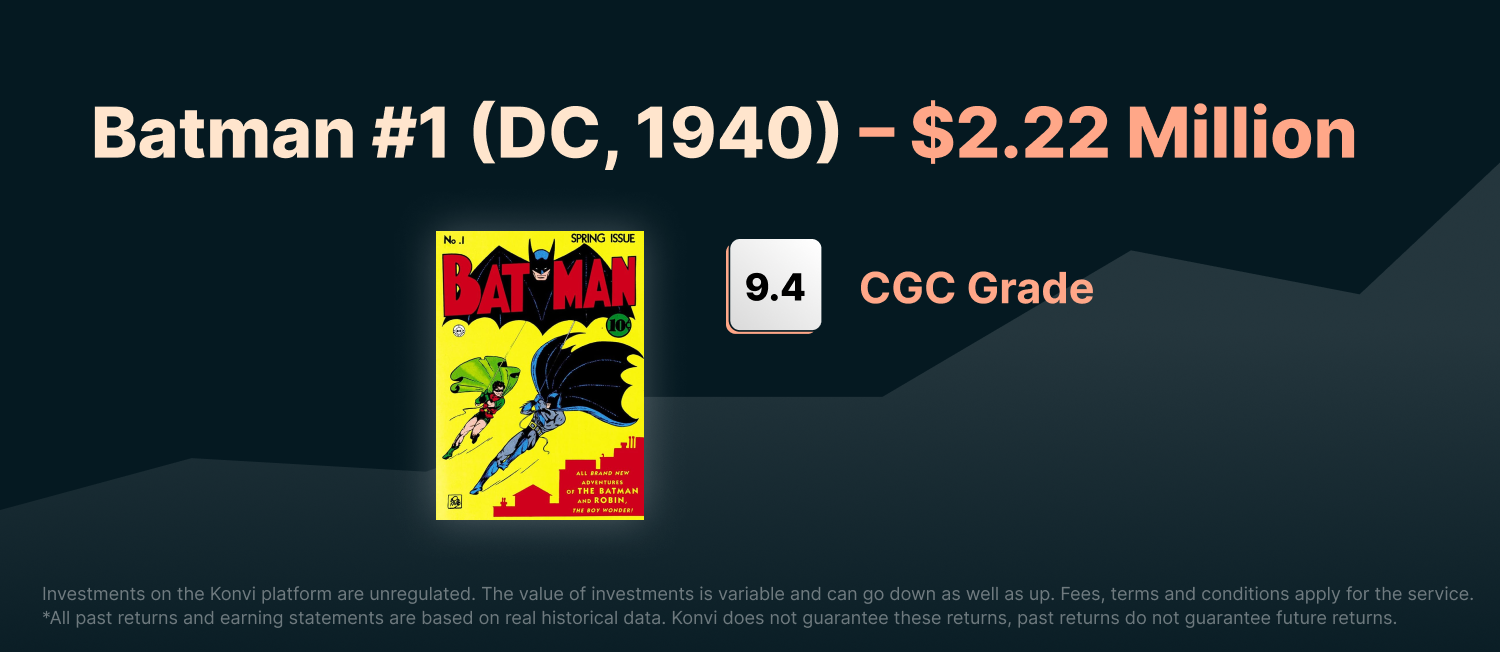
The book’s bright yellow and white cover is notoriously difficult to preserve, making this CGC 9.4 copy especially rare. It also reflects a shift in comic storytelling, delving into psychological themes and dark moral ambiguity. Its high valuation is due to the key character introductions and also the nearly flawless condition of the surviving copy.
5. Marvel Comics #1 (Timely Comics, 1939) – $2.427 Million
Grade: CGC 9.2
Sale Year: 2022
Auction House: ComicConnect
Before there was Marvel as we know it, there was Marvel Comics #1. Published by Timely Comics in 1939, this foundational issue introduced the Human Torch—later a core member of the Fantastic Four—and Namor the Sub-Mariner, one of the earliest antiheroes in comic book history. Together, they marked the beginning of what would evolve into the expansive Marvel Universe, setting a precedent for complex characters and cross-title storytelling that would come to define the brand.
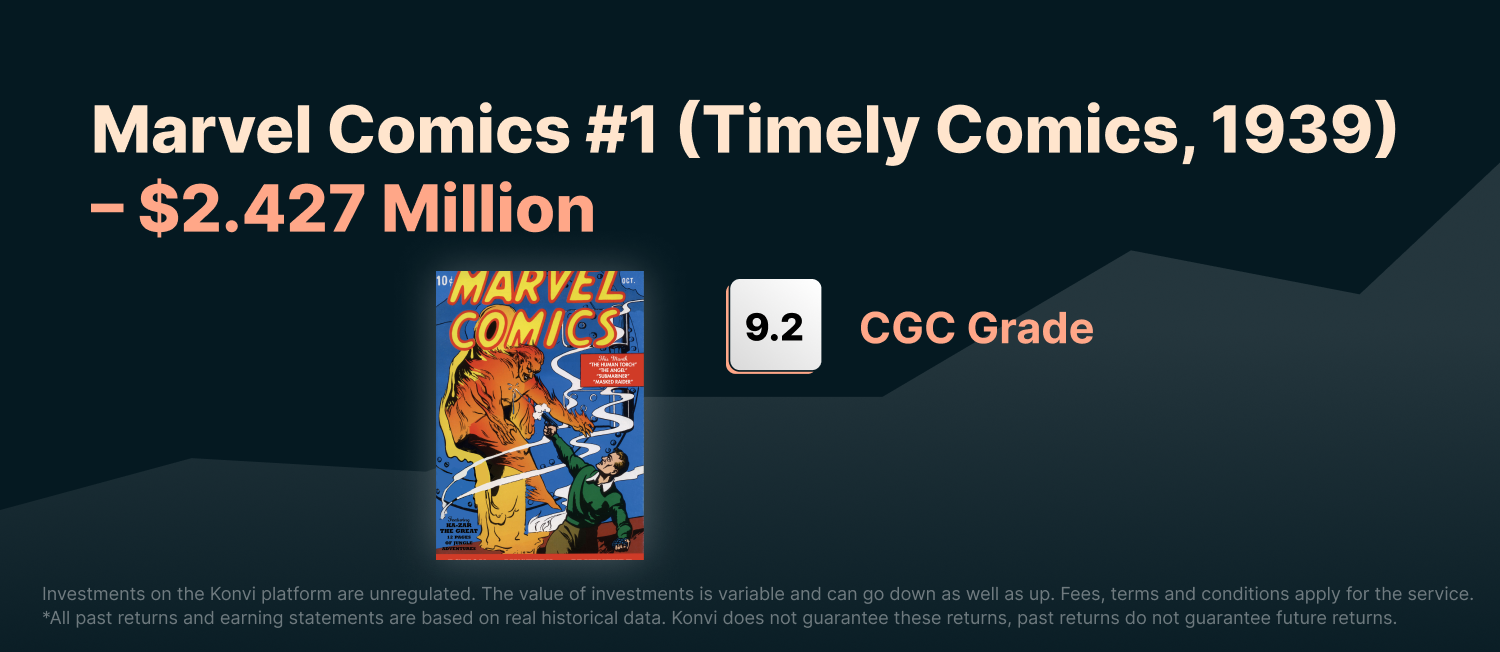
Printed during the tail-end of the Great Depression and the start of World War II, this comic is a tangible artefact of American resilience and creativity. The CGC 9.2 copy, one of the highest known grades, also comes from the esteemed San Francisco Pedigree, enhancing its provenance. Its value is driven by both its foundational role in comic history and its exceptional preservation.
4. Captain America Comics #1 (Timely Comics, 1941) – $3.12 Million
Grade: CGC 9.4
Sale Year: 2022
Auction House: Heritage Auctions
Released in March 1941—nine months before the U.S. entered World War II—Captain America Comics #1 was more than a debut; it was a bold act of political messaging. With its now-iconic cover of Steve Rogers punching Adolf Hitler, the comic served as an unambiguous stance against fascism at a time when public opinion was still divided. Created by Joe Simon and Jack Kirby, Captain America became a symbol of American ideals and wartime resilience, rallying readers behind the Allied cause and setting the tone for comics as a vehicle of cultural and ideological influence.
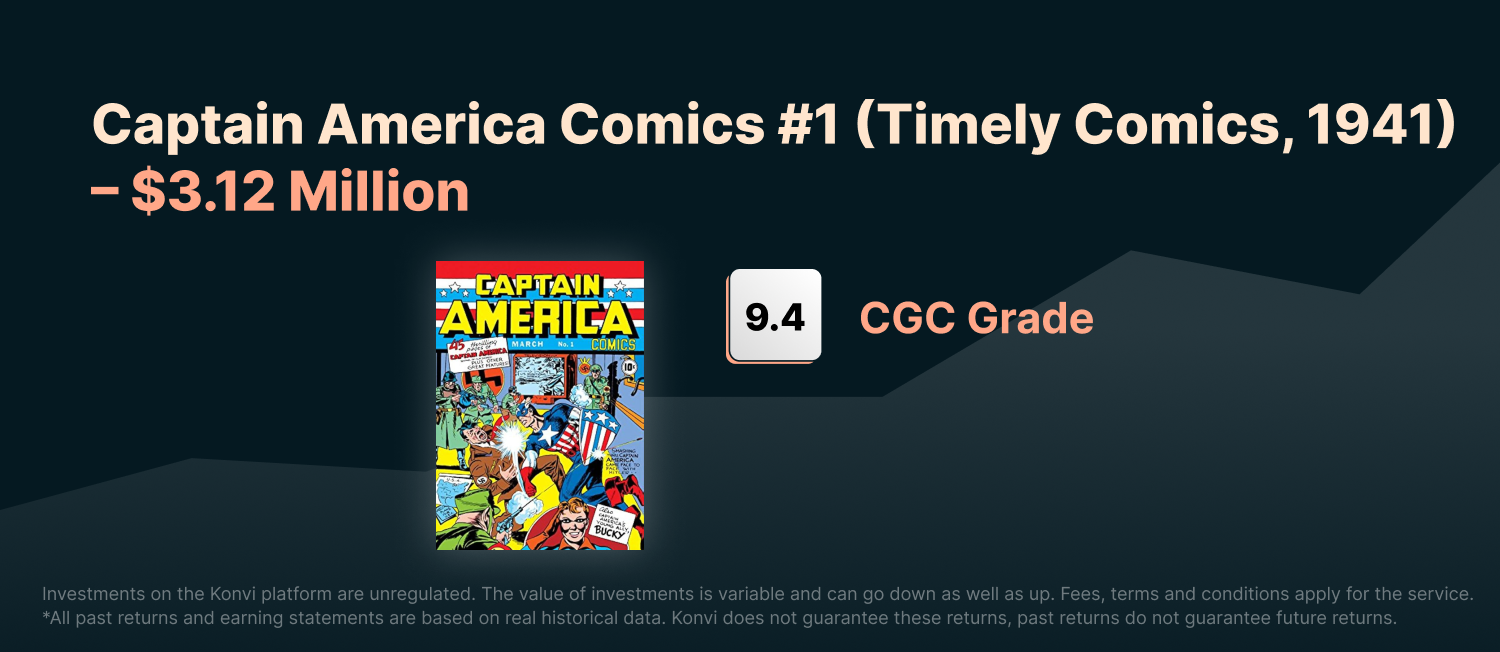
This CGC 9.4 copy hails from the famous San Francisco Pedigree and features rare distributor markings, adding to its collectability. Its combination of cultural significance, condition, and visual boldness make it one of the most celebrated comics of the Golden Age.
3. Amazing Fantasy #15 (Marvel, 1962) – $3.6 Million
Grade: CGC 9.6
Sale Year: 2021
Auction House: Heritage Auctions
The debut of Spider-Man in Amazing Fantasy #15 is widely regarded as a pivotal moment in modern comics. Created by Stan Lee and Steve Ditko, Peter Parker broke the mould of superhero perfection—he was a teenager, awkward, broke, and burdened by guilt. His everyday struggles and emotional depth made him instantly relatable, quickly earning him a devoted following among younger readers who saw themselves reflected in the mask.
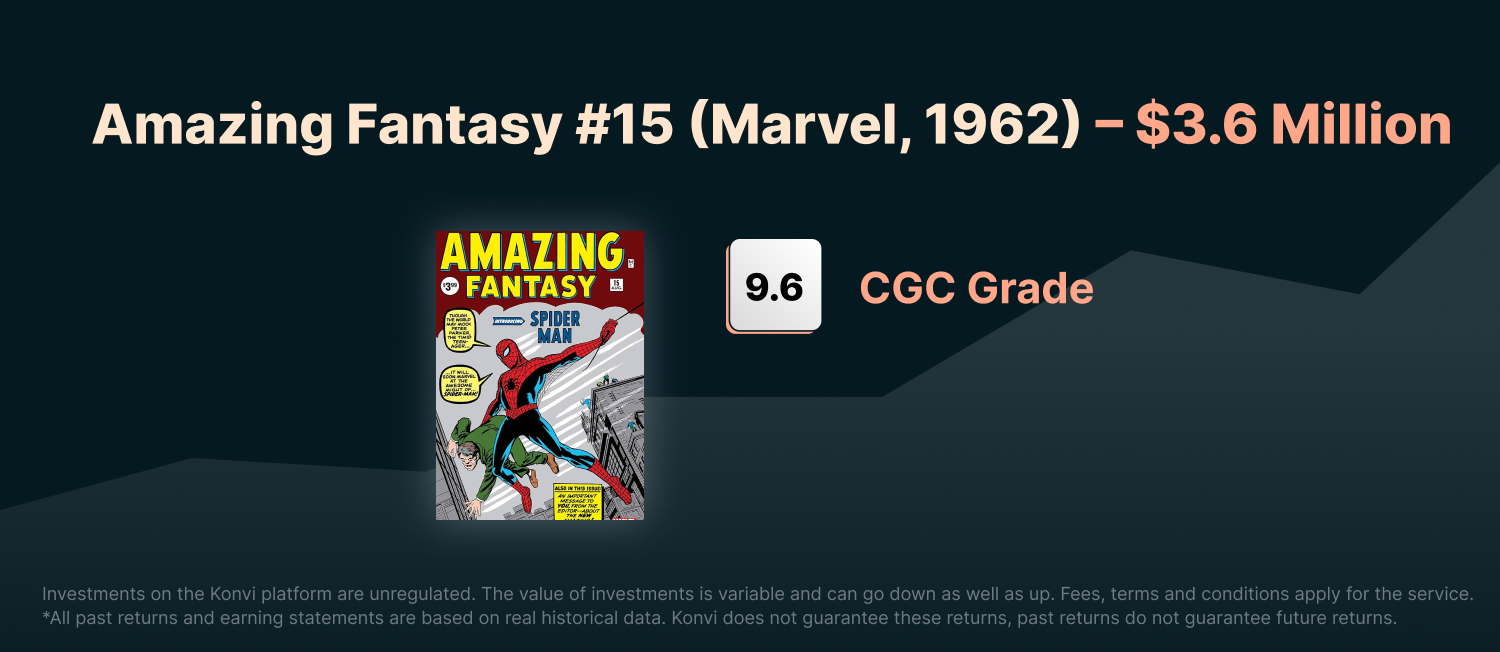
The CGC 9.6 copy that sold for $3.6 million is one of just three known at this grade, with none higher. The issue’s pop culture ubiquity, storytelling depth, and near-pristine condition make it a near-unicorn in the collector market. Its record-breaking sale underscores the immense cross-generational appeal of Marvel’s most relatable hero.
2. Superman #1 (DC, 1939) – $5.3 Million
Grade: CGC 8.0
Sale Year: 2022
Sale Type: Private Sale
Superman #1 was the first comic book dedicated entirely to a single superhero, establishing the template for character-led titles that would follow. Published in 1939—just a year after his groundbreaking debut in Action Comics #1—this issue offered readers a more expansive look at Superman’s backstory, including the destruction of Krypton, his adoption by the Kents, and the emergence of Clark Kent’s double life as a mild-mannered reporter and global saviour. It also began to shape his moral code, positioning him not just as a figure of strength, but as a champion of the oppressed. The comic’s blend of origin storytelling, social justice themes, and aspirational heroism helped cement Superman as a symbol of idealism—and set a narrative standard for superhero storytelling for decades to come.
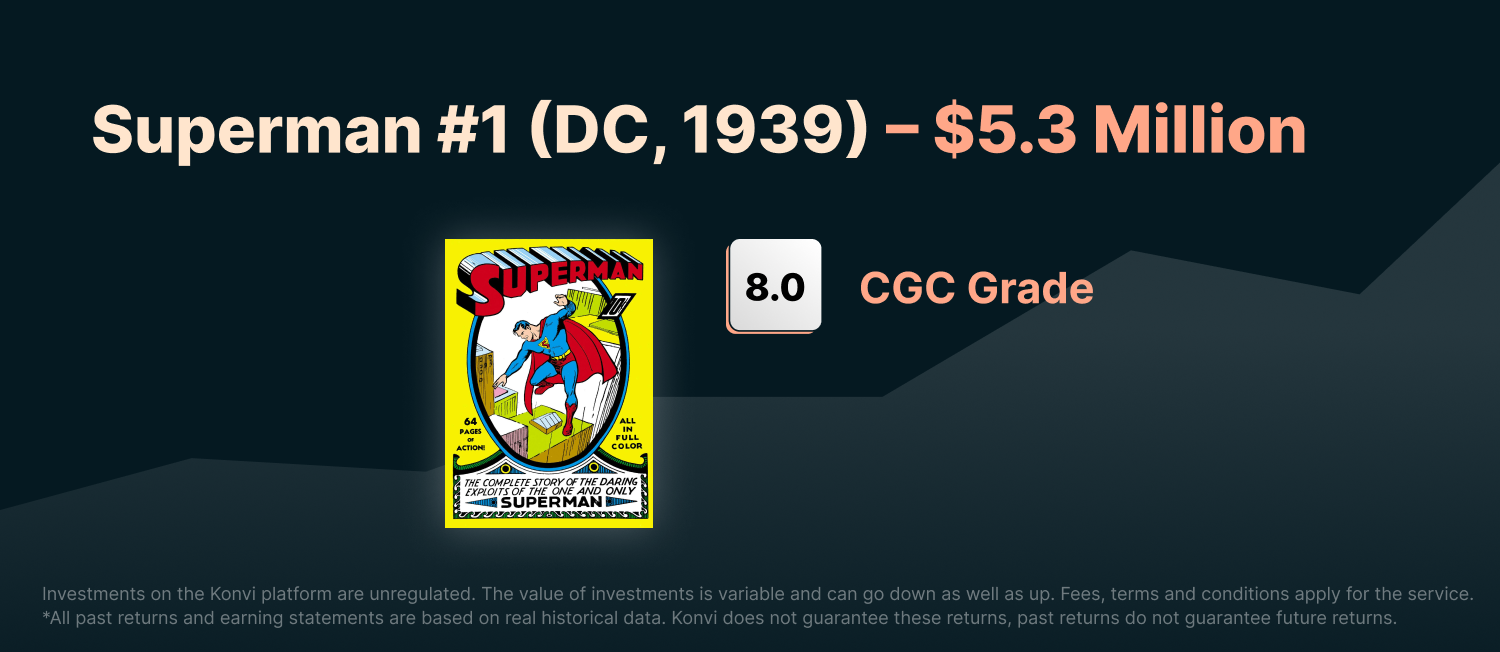
The CGC 8.0 copy that sold privately for $5.3 million is from the legendary Mile High (Edgar Church) Collection, known for its immaculate preservation. Its rarity, historical stature, and pristine lineage make it one of the most desirable comics ever sold.
1. Action Comics #1 (DC, 1938) – $6.00 Million
Grade: CGC 8.5
Sale Year: 2024
Auction House: Heritage Auctions
Now to the undisputed highlight of our top 10 most expensive comics ever sold: the book that started it all. Action Comics #1 is not just a comic—it’s the birth of the superhero genre as we know it. Published in 1938, it introduced the world to Superman, whose blend of alien strength, humble human disguise, and unwavering moral purpose set the blueprint for generations of heroes to come. The story captured imaginations with its themes of justice, identity, and power used for good—laying the cultural and commercial foundation for an entire industry. Today, Action Comics #1 is more than a collector’s item; it’s a mythic artefact that marks the moment comic books transformed into modern legends.
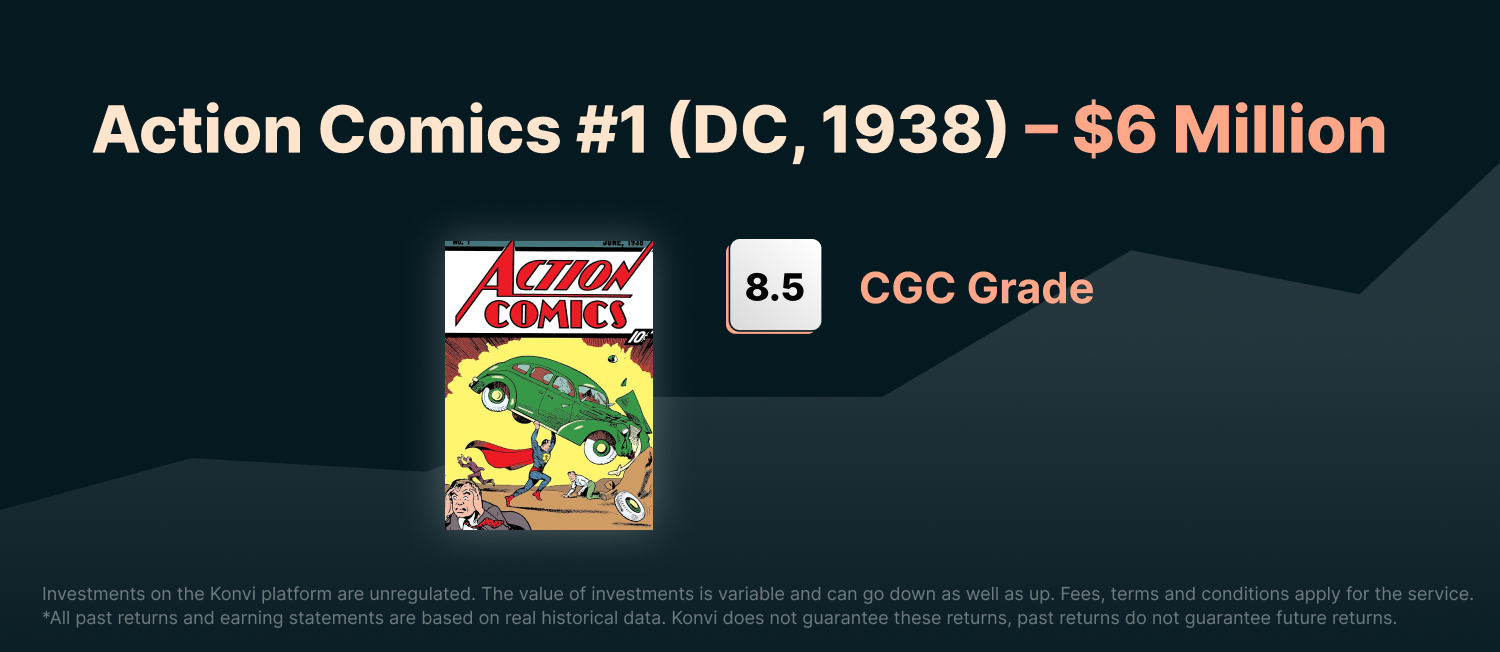
Published in June 1938, its print run was relatively small, and surviving copies are exceedingly rare. This CGC 8.5 edition is one of the highest graded and finest preserved, explaining its record-breaking $6 million price tag. Its status as the origin point of comic book mythology ensures its place atop the pantheon of collectable pop culture.
Why Rare Comic Books Hold Investment Potential
The investment case for rare comic books has strengthened considerably in recent years. Once seen as nostalgic keepsakes or collector’s curiosities, key issues from the Golden and Silver Ages are now widely regarded as cultural artefacts with measurable financial value. Thanks to certified grading, transparent auction results, and increasing mainstream interest, vintage comics have emerged as a compelling alternative asset class.
1. Certified Authenticity and Condition-Based Value
The introduction of third-party grading—led by the Certified Guaranty Company (CGC) —transformed the comic book market by offering verifiable, condition-based valuations. A comic graded CGC 9.6 or above represents near-pristine conditions, and prices can skyrocket accordingly. For example, a mid-grade copy of Amazing Fantasy #15 the (first appearance of Spider-Man) may sell for under $50,000, while a CGC 9.6 copy has sold for $3.6 million.
Condition isn’t merely a cosmetic factor—it’s a scarcity multiplier. Comics printed on cheap newsprint in the 1930s–60s were never intended to survive decades, let alone in flawless shape. That makes top-grade copies of first appearances extraordinarily rare and immensely valuable.
2. Key Issues with Cultural and Franchise Impact
Collectors and investors increasingly focus on key issues—comics marking the first appearance of iconic characters, major plot developments, or universe-defining events. These books are the narrative backbone of franchises that continue to dominate global entertainment.
Examples include:
- Action Comics #1 – Superman’s debut
- Detective Comics #27 – First appearance of Batman
- Amazing Fantasy #15 – Spider-Man’s introduction
- Tales of Suspense #39 – First appearance of Iron Man
These issues consistently rank among the most valuable in the world due to their storytelling significance, sustained pop culture relevance, and global fanbase loyalty.
3. Rarity Drives Long-Term Value
Investment-grade comics benefit from naturally constrained supply. Original Golden and Silver Age print runs were modest, and survival rates were low—especially in good condition. For instance, of the thousands of Incredible Hulk #1 copies originally sold, only a handful have received a CGC grade above 9.0. This extreme scarcity in high grades has led to copies fetching well over six figures at auction.
Moreover, even mid-grade versions of key issues retain strong liquidity, making them attractive to newer investors seeking accessible entry points with long-term upside.
4. Demand Fueled by Generational Popularity
Characters like Batman, Spider-Man, and Iron Man transcend individual media formats. They appear in films, streaming series, video games, merchandise, theme parks, and beyond—each new appearance reinforcing demand for their earliest printed origins.
The continued reinvention of these characters for successive generations has created a self-sustaining market dynamic. As the cinematic and cultural reach of both Marvel and DC continues to grow, so too does the relevance of their foundational narratives. These franchises have become pillars of global entertainment—maintaining billion-dollar footprints and commanding multigenerational fanbases.
This enduring presence ensures that early key issues—particularly those from the Golden and Silver Ages—remain highly desirable. Their importance is not just historical but culturally compounding, drawing sustained interest from Gen X and Millennial collectors today, and likely from Gen Z investors in the years ahead. The attraction to the origins of these now-universal mythologies is only expected to increase as their influence deepens across media.
5. Portfolio Diversification and Tangible Asset Security
Rare comics are tangible, insurable assets with a low correlation to traditional markets. While stocks and cryptocurrencies can be volatile, blue-chip comics offer a more stable trajectory, especially for high-grade issues with a strong sales history.
Investors increasingly view CGC-graded comics as a hedge within a broader portfolio—comparable to art, watches, or rare whisky. These books are portable, highly liquid at the upper end of the market, and backed by an engaged global collector base.
How Konvi Enables Access to Rare Comic Book Investments
While the world of rare comics holds immense financial potential, it has traditionally been reserved for seasoned collectors and high-net-worth individuals. Konvi is changing that—bringing cultural investing to a broader audience through co-ownership, expert curation, and transparency.
Expertise Through Ewbank’s Partnership
To ensure every offering meets stringent investment standards, Konvi partners with Ewbank’s, a leading auction house and expert in comic book valuation. Every asset is professionally graded, authenticated, and appraised, ensuring investors are buying into historically significant and investment-worthy comics.
Fractional Ownership Model
Konvi enables investors to gain exposure to rare comic books from as little as €250—assets that would typically require six-figure capital to acquire outright. This fractional model offers a flexible way to diversify across collectable categories, including comics, whisky, and watches, while retaining access to high-calibre, expertly curated assets.
Focus on High-Impact Cultural Assets
Konvi doesn't simply follow trends; it curates investment opportunities based on long-term market dynamics, character longevity, and cultural resonance. Whether it's a debut appearance of Batman or a high-grade Silver Age Spider-Man issue, assets are selected for their track record and future potential.
Long-Term Transparency and Ongoing Asset Oversight
Konvi is committed to maintaining full transparency throughout the entire investment lifecycle. Investors receive regular updates on each asset’s status, including market movements, expert appraisals, and emerging sales opportunities. When a potential early exit arises, the opportunity is first communicated to the investor community, who are then given the chance to vote democratically on whether or not to proceed with the sale.
While exit timelines can vary depending on asset type and market conditions, this structured, community-driven process ensures that all decisions are both data-informed and aligned with investor consensus. It reflects Konvi’s long-term approach to stewardship—providing investors with ongoing visibility and shared agency in the management of each high-value collectable.
Conclusion: A Cultural Asset Class Reimagined for Investors
Rare comic books have evolved far beyond their pulp origins to become enduring symbols of cultural identity, creative innovation, and historical storytelling. From the groundbreaking appearance of Superman in Action Comics #1 to the socially reflective narratives of the X-Men, these books chronicle the shifting ideals of generations while offering a tangible connection to modern mythology.
In an era where investors increasingly seek diversification beyond traditional markets, high-grade comic books—particularly from the Golden and Silver Ages—offer a compelling blend of scarcity, emotional resonance, and long-term collectability. Their ability to preserve and appreciate in value while engaging a dedicated global collector base makes them uniquely positioned within the alternative investment space.
With Konvi, this once-specialist domain becomes accessible. By enabling co-ownership in carefully selected, professionally authenticated comic book assets, Konvi opens up opportunities to participate in one of the most culturally rich and financially promising corners of the collectables market.
For investors looking to combine cultural passion with portfolio diversification, rare comics represent more than an investment—they are a stake in the stories that continue to shape global imagination.

